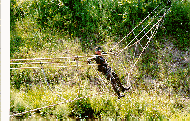SEARCH AND RESCUEWHAT DOES CAP DO?
SEARCH AND RESCUE


Thunderbolt Squadron has a Ground Team that is capable of performing a variety of search and rescue missions.
ELT SEARCHES
If a plane crashes, a device on board called an Emergency Locator Transmitter (ELT) sends out a signal which is usually first picked up via one of three satellites orbiting the United States.
The satellite notifies the United States Air Force Rescue Coordination Center (AAFRCC) of the signal, and gives a rough location. They in turn, notify the Massachusetts Wing Emergency Services (ES) Officer, who then activates the pagers of qualified Ground Team and AirCrews. The Wing ES Officer assigns a Mission Coordinator (MC), who then selects the Team Members who can offer the best response and activates them.
Weather permitting, the aircrew, a Pilot and Observer, will take the airplane to the area reported and start searching for the ELT. The Aircrew will communicate and coordinate with the Ground Team so they can go to the right area. The Ground Team, using Direction Finding Radio Equipment (DF and L-Per) will take measurements to plot a land course to the target area. Woodsman skills are very important to the ground team. They use road maps, topographical maps, compass and GPS equipment to navigate to the area and start searching for the target.
Upon locating the target, they will search for the passengers and crew of the plane and provide emergency first aid. They communicate with the Mission Coordinator to get additional resources to the scene or provide transport to an evacuation area if necessary.
DOWN PLANE WITH NO ELT SIGNAL
When a plane is missing and there is no signal, The ES appoints a Mission Coordinator (MC) who activates both Air and Ground Teams. They will proceed to the last known or suspected target area. The Aircrew will then begin using visual search patterns. When the plane locates the target the Ground Team then goes in to the area identified by the Aircrew. Coordination with the Aircrew is key.MISSING PERSONS
When a person is missing in a rural area, a request would be made for CAP Assistance by local or state authorities. Some CAP aircraft are equipped with infrared sensors, which can be very useful in locating a missing person in the woods. The Ground Teams can help local authorities in setting up search patterns and help coordinating the activities of both professional and volunteer searchers. The ground teams are trained in various sweep patterns used in searches, looking for not just the person, but any clue's they may have left. CAP's radio resources can be invaluable in coordinating a large search operation. Mass Wing has a Communications Command Truck that can be brought on scene to help establish a field headquarters as well as other equipment, such as tents and generators.DISASTER RELIEF OPERATIONS
Civil Air Patrol assists communities across the country in Disaster Relief Operations. Aerial reconnaissance for damage assessment can be performed in the air via radio transmitted video or photographs. Ground Teams can gather water samples from public drinking supplies, do damage assessment, provide communications, help with sand bagging, traffic control, perform radiological monitoring or shelter management.